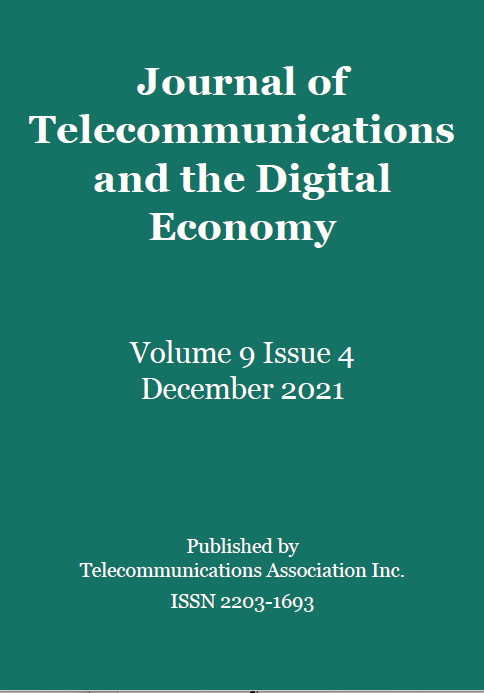Predictions from an Empirical Study in the Turkish Mobile Telecommunications Market on the Determinants of Mobile Customer Churn
Main Article Content
Keywords
Churn, Subscriber loss, Churn prediction, Switching, Customer retention
Abstract
Acquiring new customers compared to holding the existing ones is costlier and more troublesome for businesses, so customer retention is of great importance in today's intensely competitive environment. It is crucial in customer relations management to identify and analyse customers whose loyalty decreases and who tend to leave, and prevent churn through various methods under resource constraints. This issue is especially prominent in the mobile communication market. This paper uses a binomial logit model based on a survey with 637 mobile users in Turkey to determine the factors affecting customer churn and how they find their effect. Results indicate that, among various factors, network quality, billing, tariff level, tariff plan, and education level are the determinants affecting customer churn and associated with the intention to switch. Our findings demonstrate implications for both managers and rule-makers in the mobile telecommunications sector.
References
Ahn, J. H., Han, S. P., & Lee, Y. S. (2006). Customer churn analysis: Churn determinants and mediation effects of partial defection in the Korean mobile telecommunications service industry. Telecommunications Policy, 30, 552–568. https://doi.org/10.1016/j.telpol.2006.09.006
Ascarza, E., Netzer, O., & Hardie, B. G. (2018). Some customers would rather leave without saying goodbye. Marketing Science, 37(1), 54–77. https://doi.org/10.1287/mksc.2017.1057
Banda, P. K., & Tembo, S. (2017). Factors Leading to Mobile Telecommunications Customer Churn in Zambia. International Journal of Engineering Research in Africa, 31, 143–154. https://doi.org/10.4028/www.scientific.net/JERA.31.143
BTK. (2021). Quarterly market report. Available: https://www.btk.gov.tr/pazar-verileri.
Burez, J., & Van den Poel, D. (2007). CRM at a Pay-TV Company: Using analytical models to reduce customer attrition by targeted marketing for subscription services. Expert Systems with Applications, 32(2), 277–288. https://doi.org/10.1016/j.eswa.2005.11.037
Calvo-Porral, C., Faíña-Medín, A. & Nieto-Mengotti, M. (2017). Satisfaction and switching intention in mobile services: Comparing lock-in and free contracts in the Spanish market. Telematics and Informatics, 34(5), 717–729. https://doi.org/10.1016/j.tele.2016.08.022
Catalan-Matamoros, D. (ed.). (2012). Advances in Customer Relationship Management. IntechOpen. https://doi.org/10.5772/1795
Ferreira, P., Telang, R., & De Matos, M. G. (2019). Effect of Friends’ Churn on Consumer Behavior in Mobile Networks. Journal of Management Information Systems, 36(2), 355–390. https://doi.org/10.1080/07421222.2019.1598683
Garcia-Marinoso, B., & Suarez, D. (2019). Switching mobile operators: Evidence about consumers’ behavior from a longitudinal survey. Telecommunications Policy, 43, 426–433. https://doi.org/10.1016/j.telpol.2018.12.001
Gerpott, T. J., & Ahmadi, N. (2015). Regaining drifting mobile communication customers: Predicting the odds of success of winback efforts with competing risks regression. Expert Systems with Applications, 42(21), 7917–7928. https://doi.org/10.1016/j.eswa.2015.05.011
Glady, N., Baesens, B., & Croux, C. (2009). Modeling churn using customer lifetime value. European Journal of Operational Research, 197(1), 402–411. https://doi.org/10.1016/j.ejor.2008.06.027
GSMA. (2020a). The mobile economy 2021. Available: https://data.gsmaintelligence.com/.
GSMA. (2020b). Global mobile trends 2020. Available: https://data.gsmaintelligence.com/.
Guven, F. (2018). Churn and loyalty behavior of Turkish digital natives. 29th European Regional Conference of the International Telecommunications Society (ITS): https://www.econstor.eu/handle/10419/184943
Huang, B., Kechadi, M. T., & Buckley, B. (2012). Customer churn prediction in telecommunications. Expert Systems with Applications, 39(1), 1414–1425. https://doi.org/10.1016/j.eswa.2011.08.024
Jain, H., Khunteta, A., & Srivastava, S. (2020). Telecom churn prediction and used techniques, datasets and performance measures: a review. Telecommunication Systems, 76, 613–630. https://doi.org/10.1007/s11235-020-00727-0
Kar, M. (2018). Mobil telekomünikasyon piyasasında regülasyonun rekabet üzerine etkisi: Türkiye’de numara taşınabilirliği örneği, Uludağ Üniversitesi. https://doi.org/10.20409/berj.2019.173
Karacuka, M., Haucap, J., & Heimeshoff, U. (2011). Competition in Turkish mobile telecommunications markets: Price elasticities and network substitution. Telecommunications Policy, 35(2), 202–210. https://doi.org/10.1016/j.telpol.2010.12.016
Karacuka, M., Catik, A. N., & Haucap, J. (2013). Customer choice and local network effects in mobile telecommunications in Turkey. Telecommunications Policy, 37(4), 334–344. https://doi.org/10.1016/j.telpol.2012.10.005
Keaveney, S. M. (1995). Customer switching behavior in service industries: An exploratory study. Journal of Marketing, 59, 71–82. https://doi.org/10.2307/1252074
Keramati, A., & Ardabili, S. M. (2011). Churn analysis for an Iranian mobile operator. Telecommunications Policy, 35(4), 344–356. https://doi.org/10.1016/j.telpol.2011.02.009
Kim, H. S., & Yoon, C. H. (2004). Determinants of subscriber churn and customer loyalty in the Korean mobile telephony market. Telecommunications Policy, 28, 751–765. https://doi.org/10.1016/j.telpol.2004.05.013
Kim, J. K. (2005). Mobile Subscribers' Willingness to Churn Under the Mobile Number Portability (MNP). AMCIS 2005 Proceedings, 325. https://aisel.aisnet.org/amcis2005/325.
Lambrecht, A., & Skiera, B. (2006). Paying too much and being happy about it: Existence, causes, and consequences of tariff-choice biases. Journal of Marketing Research, 43(2), 212–223. https://doi.org/10.1509/jmkr.43.2.212
Lejeune, M. A. P. M. (2001). Measuring the impact of data mining on churn management. Internet Research, 11(5), 375–387. http://doi.org/10.1108/10662240110410183
Lunn, P. D., & Lyons, S. (2018). Consumer switching intentions for telecoms services: Evidence from Ireland. Heliyon, 4(5), e00618. https://doi.org/10.1016/j.heliyon.2018.e00618
McIlroy, A., & Barnett, S. (2000). Building customer relationships: Do discount cards work? Managing Service Quality, 10(6), 347–355. https://doi.org/10.1108/09604520010351491
Mahajan, V., Misra, R., & Mahajan, R. (2017). Review on factors affecting customer segmentation in telecom sector. International Journal of Data Analysis Techniques and Strategies, 9(2), 122–144. https://doi.org/10.1504/IJDATS.2017.085898
Mozer, M. C., Wolniewicz, R. H., Grimes, D. B., Johnson, E., & Kaushansky, H. (2000). Churn reduction in the wireless industry. In Solla, S., Leen, T., & Müller, K. (eds), Advances in Neural Information Processing Systems 12, pp. 935–941.
NTS. (2021). Number Portability. Available: http://www.nts.gov.tr/surecler.html.
Óskarsdóttir, M., Bravo, C., Verbeke, W., Sarraute, C., Baesens, B., & Vanthienen, J. (2016). A comparative study of social network classifiers for predicting churn in the telecommunication industry. Advances in Social Networks Analysis and Mining (ASONAM), 2016 IEEE/ACM International Conference on. IEEE, 2016.
Saleh, K. (2017). Customer Acquisition vs. Retention Costs – Statistics and Trends. Available: https://www.invespcro.com/blog/customer-acquisition-retention/.
Sharma, A., & Panigrahi, D. (2011). A neural network-based approach for predicting customer churn in cellular network services. International Journal of Engineering and Computer Science, 27(11), 26–31. http://dx.doi.org/10.5120/3344-4605
Shujaat, S., Ahmed, U., & Syed, N. (2015). Factors behind brand switching in telecom sector of Pakistan. IBT Journal of Business Studies, 11(2), 29–40.
Uner, M. M., Guven, F. & Cavusgil, S. T. (2020). Churn and loyalty behavior of Turkish digital natives: Empirical insights and managerial implications. Telecommunications Policy, 44(4). https://doi.org/10.1016/j.telpol.2019.101901






